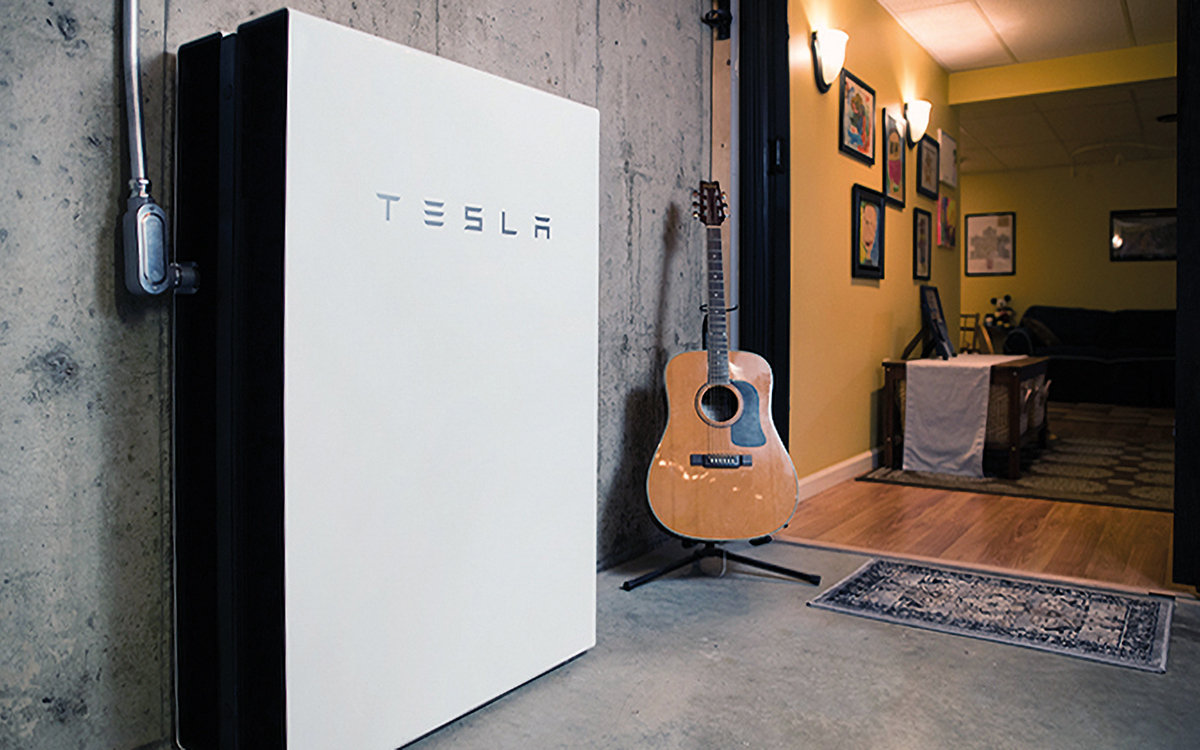An electricity utility company in Vermont, US, is so fed up of storms and extreme weather damaging power lines that it is encouraging its customers to have batteries at home so it can keep the lights on when the power goes off. Andrew Draper reports.
Green Mountain Power (GMP) reckons the cost will be recouped and is in contrast to the $45 million it spent restoring power last winter after severe storms caused disruption.
GMP has been given the go-ahead by the Vermont Public Utility Commission to add more customers to its Powerwall and Bring Your Own Device (BYOD) home battery schemes.
The New England state has endured a series of devastating storms and floods in recent years and decided batteries were a cheaper and easier option than building more power lines and continually battling to fix lines and poles that had been brought down by heavy, wet snow and falling trees. Climate change is making the weather more severe, the company said.
Climate change and cyber threats
It drew up and filed a Climate Plan in 2020 with the Commission. It now says storms are increasing in magnitude, frequency, severity of damage, resulting in significantly greater restoration costs than expected, even from when the climate plan was filed. Other physical and cyber threats to the regional grid are also increasing, it said.
In its petition in October 2023 to the utility commission in favour of its Zero Outages Initiative, GMP argued it could put an end to power cuts by:
- storm hardening lines (physically changing infrastructure to make it less susceptible to damage from extreme weather)
- creating community microgrids in targeted areas
- deploying residential battery storage.
It would apply each solution depending on what was most effective for customers, it said.
Sharing battery power to the grid

According to Tesla, each 114kg battery Powerwall has 13.5kWh capacity and can operate from -20°C to 50°C.
Customers can also buy their own battery and have it installed, and get a refund of up to $10,500 from GMP, depending on how much energy they agree to share during peak demand.
Since 2020, both the Powerwall and BYOD schemes had been capped at 500 customers, or 5MW of energy storage per scheme per year. The waiting list was full into 2026. About 300 customers joined the waiting list last summer, following historic flooding in the state. The lifting of the cap on the scheme in August allowed more people to join.
Virtual power plant
The utility company, which supplies around 270,000 residential and business customers in Vermont, estimates some 3,000 customers have over 4,800 batteries in their homes. GMP networks them along with utility-scale batteries and devices such as car chargers into a virtual power plant with around 50MW of stored energy. The company claims this stored energy network has saved customers $3 million a year for the last few years.
GMP has partnered with Tesla since 2017. Its filing to the Vermont Public Utility Commission sought authorisation to initially spend $280 million to strengthen its grid and $30 million for the home energy storage scheme, to be spent in 2025 and 2026. The batteries will come from various manufacturers.
It expects to invest $1.5 billion over the next seven years and recoup costs from electricity charges.
Preparing for long-duration energy storage
GMP CEO Mari McClure has said the approach is about creating virtual networks now as preparation for long-duration energy storage, which the company expects to become more cost-effective in time.
The company said in its petition that much of its coverage area is rural, where providing storm protection or burying cables is harder. Storage-based solutions will be the preferred solution to help customers get through power cut situations.
“Customer storage systems have proven their ability to provide reliability benefits while generating savings for all customers,” the company said in its petition. “For example, in the storms last winter, customers with battery systems remained powered up for more than 77,000 hours in approximately 2,300 separate events, with many customers riding out the entire outage event affecting their community. As a result, GMP’s Energy Storage System tariff, which leases batteries to participating customers, has long had a lengthy application waitlist.”
In future, a combination of utility-provided storage solutions and customer-provided storage opportunities such as vehicle-to-home and vehicle-to-grid, means GMP sees a future where all customers have access to this flexible, critical resiliency resource.
‘Storage will play a central role’
In testimony to the Vermont State Utility Commission in October, Josh Castonguay, GMP’s Chief Innovation Executive, said their customers could not continue facing the brunt of climate change when solutions exist to can help them.
“Storage will play a central role in providing zero outages to customers,” he said, adding: “We have already proven that our customers can achieve a zero-outage experience thanks to the combination of hardening our distribution system and adding energy storage and it is time we scale this up for every customer, no matter where they live, or what they can afford.”
Other schemes it is looking at include vehicle to home (V2H), vehicle to grid (V2G) and vehicle to everything (V2X). They provide back-up capacity in addition to valuable time-shifting load management and storage-paired solar that can help customers through longer power cuts.
Being able to provide reliable and resilient electricity, which is what customers expect – regardless of location or their financial situation – is important as people use technology at home for work, education and health care, said Castonguay. People with oxygen machines at home, for example, were particularly keen to sign up, he said.
Will the grid handle electrification transition?
He added: the company is often asked whether the grid will be able to handle the transition to a more electrified future. “GMP continues to answer that question with a resounding yes, both due to the fact that we are leading in the ability to manage flexible electric resources and because we continue to deploy battery storage systems,” he said.
“With the heavily distributed storage network, working integrally with the distributed loads and generation, we can manage the grid in an entirely new way, making it flexible, bi-directional, and a cost-saving lever for all customers.”
EVs ‘another battery’
Customers will, in future, be able to think of their electric vehicles (EVs) as “another battery” to power their homes when needed, providing greater resiliency. There are some 10,000 EVs in Vermont, 7,000 owned by GMP customers. The number is set to grow and tapping into that power will be an important accompaniment, according to the company.
Castonguay said: “By way of comparison, two Powerwall batteries in a home will provide about 27kWh of energy storage backup, and the average electric vehicle can have between 85 and 120kWh of stored energy. For some customers, having an EV in their garage is like having 10 Powerwall batteries to tap into.”
GMP has provided portable battery systems, from large transportable power systems capable of backing up entire circuits to small batteries that can bridge critical loads for customers in need.
It has been testing V2X and V2G applications, and working with the South Burlington School District to use stored energy from electric buses while not in use. It has also used long-duration energy storage to keep an entire circuit on in the town of Proctor and keeping a large business powered during a power cut.












